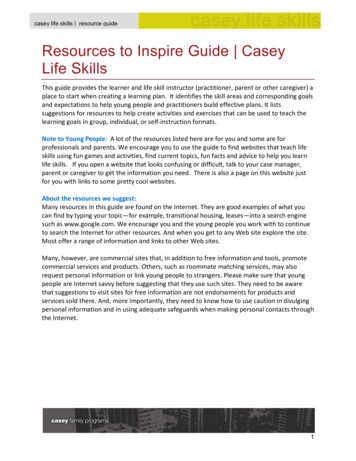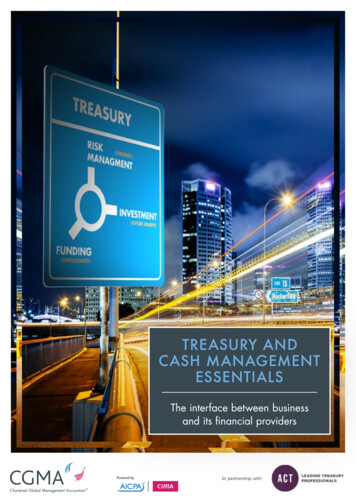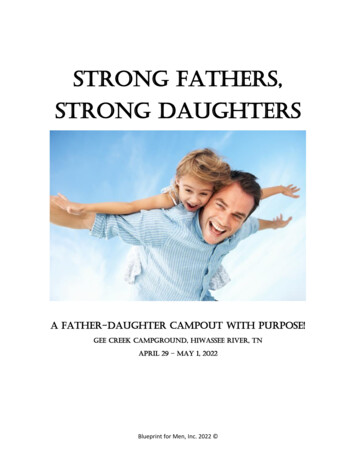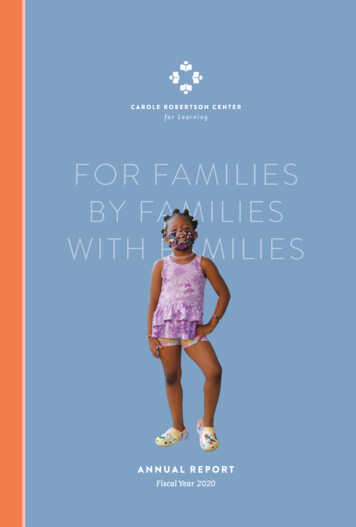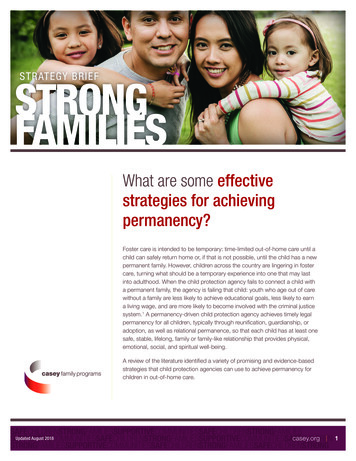
Transcription
STRATEGY B RI E FSTRONGFAMILIESWhat are some effectivestrategies for achievingpermanency?Foster care is intended to be temporary: time-limited out-of-home care until achild can safely return home or, if that is not possible, until the child has a newpermanent family. However, children across the country are lingering in fostercare, turning what should be a temporary experience into one that may lastinto adulthood. When the child protection agency fails to connect a child witha permanent family, the agency is failing that child: youth who age out of carewithout a family are less likely to achieve educational goals, less likely to earna living wage, and are more likely to become involved with the criminal justicesystem.1 A permanency-driven child protection agency achieves timely legalpermanency for all children, typically through reunification, guardianship, oradoption, as well as relational permanence, so that each child has at least onesafe, stable, lifelong, family or family-like relationship that provides physical,emotional, social, and spiritual well-being.A review of the literature identified a variety of promising and evidence-basedstrategies that child protection agencies can use to achieve permanency forchildren in out-of-home care.Updated August 2018casey.org 1
What are some effective strategies for achieving permanency?A sense of urgencyA stable workforceBecoming a permanency-driven organizationinvolves establishing a culture and philosophy ofpermanency as everyone’s responsibility, not just thepurview of the permanency caseworker. It requires asustained sense of urgency that begins the momenta child comes to the attention of the agency with acall to the hotline. It means adopting a systemwideunderstanding that a youth’s sense of belonging isfundamental to overall well-being,2 and that relationaland legal permanency is the only way to achieve that.It requires ongoing messaging and prioritization byleadership, at the executive level as well as throughoutthe organization,2 in defining permanency as a rightand an urgent need through regular permanencyreviews, training series, data dashboards, supervisorytools, coaching sessions, and continuous qualityimprovement activities. It also requires making visibleand meaningful what happens to youth if permanencyisn’t a priority: aging out of foster care into adulthoodalone. For example, Anu Family Services, a privateagency in Wisconsin, improved permanency outcomesby 84 percent after becoming a permanency-drivenorganization through extensive changes in practice thatreflected these commitments.2Reducing worker turnover is an important factor forachieving timely permanency and equally importantto a strong organizational culture. High turnover is awidespread challenge that impacts performance ofchild protection agencies, carries significant financialcosts to these agencies, and, more importantly, hasbeen linked to negative outcomes for children andfamilies who come in contact with those systems.4One seminal study found that children in care whohad only one caseworker achieved permanency 74.5percent of the time, but as the number of caseworkersincreased, the percentage of children achievingpermanency decreased significantly: children who hadtwo caseworkers achieved permanency 17.5 percent ofthe time, and only 0.1 percent of children who had sixor seven caseworkers achieved permanency.4Casey Family Programs’ Rapid Permanency Reviews(RPRs) are another approach to elevating the issueof permanency, and galvanizing agency attention andresources on permanency for long-stayers. RPRs takean in-depth look at expediting permanency for childrenwho have been in foster care for more than two yearsand help agency leaders identify barriers to permanencyand bright spots in permanency practice.3 Preliminarydata from three jurisdictions show that childrenwho participated in an RPR achieved permanencyconsiderably faster than children in cohorts from theyear before RPRs were implemented. For example, inone jurisdiction, 74 percent of children who participatedin an RPR achieved permanency, compared with only35 percent of children from the previous year’s cohort.Perhaps even more important are the systemic barriersthat the process uncovers; addressing those barriershelps prevent additional children from lingering in care.Prior research has linked safety, organizational andsupervisory support, organizational climate and culture,and worker stress, exhaustion, and job satisfactionwith turnover and caseworkers’ intent to leave.5 Somestrategies for addressing worker turnover include:manageable supervisory ratios and caseloads;mentoring and coaching; building a safety culture;flexible schedules; and a comprehensive system forongoing learning and professional development.5VisitationIf a child has been removed from the care of his orher parents, safe and timely family reunification is thepreferred permanency option for most children. Whilechildren are in out-of-home care, it is important forthem to have consistent and quality visits with theirfamilies. Research correlates parent-child visits withhigher rates of returning home and shorter foster careplacement.6 A quality visit builds on parents’ strengthsand guides improved parenting, which may, in turn,improve the chances of children staying in their homesafter reunification.Agencies nationally have found that coached visitscan be more effective than supervised visits.7 Visitcoaches are actively involved in supporting parentscasey.org 2
What are some effective strategies for achieving permanency?to demonstrate their best parenting skills and makeeach visit fun for the child. They help parents takecharge of visits, model for parents who may not beattentive to the child how to focus on their child’s need,guide parents, and bolster parents in supporting thechild’s adjustment to foster care in part by facilitatinga relationship between the birth and foster parents.With visit coaching, parents can use visitation time tobuild relationships with their children and enhance thetransition from foster care to reunification.6Teaming with parentsBuilding a quality relationship between birth parentsand resource families is also integral to advancingfamily reunification. Ensuring that parents and resourcefamilies engage in building their relationship is in thebest interest of the child, both while the child is incare and after the child transitions home. The YouthLaw Center’s Quality Parenting Initiative (QPI) is oneapproach that incorporates birth parent and resourceparent teaming to strengthen out-of-home care. In fact,foster parenting is often rebranded as co-parenting,and foster parents are expected to support reunificationby building relationships with birth parents, modelingsafe and developmentally appropriate parenting, andmentoring birth families as appropriate.8 Sites havereported measurable improvement in several outcomeareas, including reunification.9In addition, family teaming models — also knownas family group decision-making, family teamconferencing, permanency teaming, and teamdecision-making meetings — should be usedregularly throughout the life of a case to increasefamily engagement in the child’s case plan, especiallywhen planning for permanency. They are designed toinvolve children, families, their support networks, andprofessionals as integral players on strengths-based,solution-focused teams. The team values the family’svoice, while focusing on the safety, permanency, andwell-being of the child.10,11 One such model is TeamDecision Making (TDM), a collaborative practiceused by child protection agencies that includesfamily members for all decisions involving childremoval, change of placement, reunification, or otherpermanency plans, rather than the traditional modelof agency personnel making the decisions in isolation.Sites practicing TDM were nearly 30 percent more likelyto reunify children with their families within 12 months ofentering care, finding that lengths of stay were shorterwhen families were involved in placement decisions.12Parent partner programs are another way to engageand support birth parents and have shown promise inimproving reunification. Parent partner programs drawon the lived experience of parents who were previouslyinvolved with the child welfare system to assist currentlyinvolved parents. Parent partners13 serve as mentorscasey.org 3
What are some effective strategies for achieving permanency?and advocates, support birth parents in navigating thechild welfare system and, most importantly, provideparents with hope that they can be reunified with theirchildren. Research shows that these programs canincrease reunification rates for participating families.14Parent Partner programs in Washington state andContra Costa County, California, have noted thefollowing benefits: in Washington, rates of reunificationare significantly higher in counties in which there is aParent for Parents program, as compared to countieswithout the program;15 and, in Contra Costa County,62 percent of children whose parents were mentoredthrough the program were reunified within 18 months ofremoval, compared to just 37 percent of children whoseparents did not have a Parent Partner.16Another important partner for parents is their attorney.The federal government encourages high quality legalrepresentation for parents17 but does not require it;therefore, legal representation for parents varies fromjurisdiction to jurisdiction. At least one evaluation foundthat when parents have an attorney to represent themin child welfare proceedings, reunification occursmore quickly, and when that is not possible, thenpermanency through adoption and guardianship is alsoachieved more quickly.18Removing barriers to services is another critical rolethat child protection agencies can play in supportingreunification of families, including timely access toin-home services.19 Among other things, in-homeservices aim to strengthen parental capacity andsupport healthy and nurturing relationships, in thenatural environment of the family home.20 In-homeservices can be especially appropriate while a child istransitioning back home, and post-reunification in-homeservices have been found to contribute to positiveoutcomes.20 For example, Homebuilders , a home- andcommunity-based intensive family preservation service,has been found by the California Evidence-BasedClearinghouse as a promising intervention to supportreunification; at least one study found that whenfamilies received Homebuilders services, childrenwere more likely to be reunified, and in less timeKENTUCKY’S SOBRIETY TREATMENTAND RECOVERY TEAM (START) An intensive in-home program forfamilies involved with the child protectionagency that have at least one childunder the age of 6, and also have asubstance use disorder. Designed to prevent the need forplacement by safely keeping childrenwith their families, or to supportsafe reunification. START provides each family with aspecially trained caseworker and a parentpartner who together engage the familyin individualized wrap-around services,including rapid access to substanceabuse treatment and other servicesas appropriate. Outcomes indicate that at case closure,over 75% of children served by STARTremained with or were reunified withtheir parent(s), and for every 1 spent onSTART, 2.22 is saved on out-of-homeplacement tart.aspxthan children whose families did not participate inHomebuilders .21Finding and engaging kinWhen children are placed in out-of-home care, it isthe agency’s responsibility to ensure that childrenare able to maintain relationships with their extendedfamily and fictive kin. If those relationships don’texist or have been disrupted, it is also the agency’sresponsibility to build or rebuild them. Researchcasey.org 4
What are some effective strategies for achieving permanency?shows that children placed with relatives experiencegreater placement stability and permanency throughguardianship than children placed with non-relatives.22To connect children in care with relatives and fictivekin, and nurture long-term relationships in permanentfamilies, effective family search and engagement (FSE)strategies can be implemented from the momentthey enter care.When kin are identified but live in a different statethan the child, this can pose significant barriers toachieving timely permanency. The Interstate Compacton the Placement of Children (ICPC), which sets forththe procedures that states must follow in order toplace children across state lines, is often known tobe a time-consuming process with no accountabilityfor ensuring that the process moves forward in atimely manner. The new National Electronic InterstateCompact Enterprise (NEICE) aims to improve theICPC process by transferring data electronicallyfrom state to state, and to increase accountability byproviding information about the status of cases thatare in process. One evaluation of NEICE in six statesfound a 20-40 percent reduction in time to placementfor children.23Another strategy for expediting placement with a relativeacross state lines, particularly in communities thatare close to the state border, is a border agreementbetween neighboring counties and states, such as thatbetween Georgia and Alabama.24Supporting guardianshipIf reunification is not possible, child protection agenciesare responsible for ensuring that children and youthachieve legal permanency through guardianship oradoption. For youth who are reluctant to have legalties permanently severed with their birth parents, aswould occur through adoption, guardianship may bea more appropriate path to a legal and permanentfamily. Guardians, who may be relatives or nonrelatives(depending on state law), are given parentalresponsibility and authority for the youth by a court.Historically, one barrier to guardianship has been thelack of ongoing financial support to permanently carefor the child, such as the subsidies available to adoptivefamilies. In 2008, the Fostering Connections Act offeredstates and tribes the option, under Title IV-E, to provideguardianship assistance payments (GAP) to relativeswho take legal guardianship of children who havebeen in out-of-home care. This assistance appearsto be making a difference: nationally, the percentageof children exiting care to guardianship has steadilyincreased from 6 percent in FY2010, to a high of 10percent in FY2016, the most recent year for whichdata from the Adoption and Foster Care Analysis andReporting System (AFCARS) is available.25In addition, the Family First Prevention Services Act of2018 allows states to receive federal reimbursementfor up to 50 percent of their expenditures for kinshipnavigator programs that meet certain criteria. Kinshipcasey.org 5
What are some effective strategies for achieving permanency?navigator programs are often a critical source ofinformation and support for relatives caring for children,including information on how to become legal guardiansfor those children and how to access services after thechild protection agency is no longer involved.26 Increasing the rate of retention of prospectivefoster and adoptive parents: supporting resourcefamilies so that they feel equipped to meet theneeds of the children in their care, including:connecting waiting families with other waitingfamilies so that they can begin to build a supportnetwork; creating a formalized peer supportnetwork of new and experienced resource families;and providing families with information and trainingto effectively address children’s specific needs. Engaging effectively with diverse cultural, racial,and economic communities: building relationshipswith diverse communities and populations torecognize and honor the diversity of children incare, as well as the diversity of adoptive families,training staff in cultural humility, and finding waysto address language barriers. AdoptUSKids photolisting: using this free serviceavailable to employees of all public and privatechild welfare agencies to either list children whoare in need of an adoptive family, or to helpadoptive families find a waiting child. General, targeted, and child-specific recruitment:employing a three-pronged approach that includesgeneral recruitment strategies to build interest andawareness of the need for adoptive families (suchas billboards and Public Service Announcementson radio programs); targeted recruitmentstrategies to focus on specific communities thatare most likely to become adoptive families forchildren with specific characteristics (such asolder youth, LGBTQ youth, or sibling groups); andchild-specific recruitment to help identify adoptivefamilies for a specific child, such as:Diligent adoption recruitmentComprehensive, multifaceted diligent recruitmentinvolves a systematic approach to recruiting, retaining,developing, and supporting a pool of adoptive familieswho reflect the diverse demographics and needsof children in need of placement. Implementingcomprehensive diligent recruitment can help achieveimproved placement stability and permanency forchildren27 by identifying relatives or, when relatives arenot available, non-relatives who are willing to becomea child’s permanent family. Some elements of a diligentrecruitment plan noted by the National Resource Centerfor Diligent Recruitment include: Analysis of the current pool of families: using datato track and analyze information about currentadoptive families can help identify gaps and needs,to inform recruitment of new adoptive families,including market segmentation. Partnerships with community groups: buildingmeaningful partnerships with agencies in localcommunities and with specific groups, such asmilitary and faith-based communities to developa pool of adoptive families that are more likelyto match the characteristics and needs of thechildren they serve, as well as embeddingcommunity-based recruitment teams in specificgeographic regions. Using a customer service model: treating potentialadoptive families with respectful customer serviceto lay the foundation for trusting partnershipsbetween families and the agency. For example,ensuring that every call is answered by a liveperson who can answer questions, or thatmessages left after business hours are returnedthe next business day, gives a positive firstimpression that the family’s call is important. Wendy’s Wonderful Kids (WWK), whichfocuses on recruiting adoptive families forchildren ages 9-18 in foster care, particularlychildren most at risk of aging out of care(e.g., older youth, youth with mental healthchallenges, sibling groups, and childrenwho have already been in care for significantperiods of time and in multiple placements).casey.org 6
What are some effective strategies for achieving permanency?Managed by the Dave Thomas Foundationfor Adoption, WWK has shown somepromising results:28 at least one study foundthat children served by WWK were 1.7 timesmore likely to be adopted than children notreceiving WWK services.29 You Gotta Believe (YGB), a New YorkCity-based organization that focusesexclusively on finding permanent familiesfor young adults, teens, and pre-teens infoster care, working with them to identifysignificant people in their lives or elsewherewho will make an unconditional, lifetimecommitment to them. YGB has madesuccessful matches in 50-60 percent ofyouth referred.30 In one 4-year federallyfunded study, 98 of the 199 youth referredto YGB achieved permanency, andprospective parents who signed up fortraining because they had a specific teenin mind for adoption were far more likelyto meet all requirements and have a teenplaced with them than those who took thetraining without a specific teen in mind.31To learn more, visit Questions from the field at Casey.org.1Courtney, M.E., Dworsky, A., Cusick, G.R., Havilcek, J., Perez, A., & Keller, T. (2007). Midwest evaluation of the adult functioning of former foster youth: outcomes atage 21. Retrieved from est-Eval-Outcomes-at-Age-21.pdf2Anu Family Services and Center for Advanced Studies in Child Welfare. (2013). Creating a Permanence Driven Organizational: A Guidebook for Change in ChildWelfare. Retrieved from e, for example, er, C., McDonald, J. & Sumski, M. (2005). Review of turnover in Milwaukee county private agency child welfare ongoing case management staff. Retrieved fromhttp://www.uh.edu/socialwork/ docs/cwep/national-iv-e/turnoverstudy.pdf5Casey Family Programs. (2018). How does turnover affect outcomes and what can be done to address retention? Retrieved from ia/HO Turnover-Costs and Retention Strategies.pdf6Adoptive and Foster Family Coalition. (2016). Visit coaching: Meeting children’s needs. Retrieved from s/7Child Protection Best Practices Bulletin: Innovative Strategies to Achieve Safety, Permanence, and Well-Being. (2011). Parent-child visitation. Retrieved from -Child%20Visitation%20%282011%29.pdf8QPI 4 Kids Network: Site Practices & Policies. (2017). Retrieved from outh Law Center. (2012). Quality Parenting Initiative. Retrieved from .org 7
What are some effective strategies for achieving permanency?10 Child Welfare Information Gateway. (2016). Family engagement: Partnering with families to improve child welfare outcomes. Retrieved from /11 Annie E. Casey Foundation. (2014). Team Decision Making case study: Engaging families in placement decisions. Retrieved from /12 Annie E. Casey Foundation. (2014). p. 3; Usher, L., Wildfire, J., Webster, D., & Crampton, D. (2010). An evaluation of the anchor-site phase of Family to Family.Baltimore, MD: Annie E. Casey Foundation; Pennel, J., Edwards, M., & Burford, G. (2010). Family group engagement and child permanency. Children and YouthServices Review, 32, 1012- 1019.13 Child Welfare Information Gateway. (2016).14 Enano, S., Freisthler, B., Perez-Johnson, D., & Lovato-Hermann, K. (2017). Evaluating Parents in Partnership: A preliminary study of a child welfare interventiondesigned to increase reunification. Journal of Social Service Research, 43, 236–245.15 Newby, M., & Thomas, G. (2015). Parents for Parents (P4P) Program (Unpublished report). Seattle, WA: Partners for Our Children, University of Washington Schoolof Social Work.16 U.S. Department of Health and Human Services, Administration for Children and Families, Children’s Bureau. (2010). Family involvement in the “Improving ChildWelfare Outcomes Through Systems of Care” initiative. Retrieved from ment Report.pdf17 Administration for Children and Families. (2017). Information memorandum: ACYF-CB-IM-17-02. Retrieved from strative/child law/ParentRep/legalrepim2017.authcheckdam.pdf18 Partners for Our Children. (2011). Executive summary: Evaluation of the impact of enhanced parental legal representation on the timing of permanency outcomes forchildren in foster care. Retrieved from CommitteeMeetingDocument/3163519 Child Welfare Information Gateway. (2017). Supporting Successful Reunifications. Retrieved from https://www.childwelfare.gov/pubPDFs/supporting reunification.pdf20 Child Welfare Information Gateway. (2014). In-home services in child welfare. Retrieved from https://www.childwelfare.gov/pubPDFs/inhome services.pdf21 Fraser, M. W., Walton, E., Lewis, R. E., Pecora, P. J., & Walton, W. K. (1996). An experiment in family reunification: Correlates of outcomes at one-year follow-up.Children and Youth Services Review, 18(4/5), 335-361.22 Campbell Collaboration. (2016). The health and well-being of children placed in kinship care is better than that of children in foster care. Retrieved from nts/PLS Kinship Care.pdf23 National Electronic Interstate Compact Enterprise. (2018). Time is running out: Accessing federal support to improve child welfare placements across statelines [Webinar].24 To learn more, see How can an effective border agreement support timely placement with kin? at Questions from the Field.25 Children’s Bureau. (2017). Adoption & foster care statistics. Retrieved from y/statistics-research/afcars26 Grandfamilies.org. (2018). Kinship navigator programs – Summary & analysis. Retrieved from alysis27 National Resource Center for Diligent Recruitment at AdoptUsKids. (nd). Diligent Recruitment. Retrieved from http://www.nrcdr.org/diligent-recruitment28 The California Evidence-Based Clearinghouse for Child Welfare. (2017). Child-focused recruitment: Wendy’s Wonderful Kids. Retrieved from itment-wendy-s-wonderful-kids/29 Vandivere, S., Malm, K., Zinn, A., Allen, T., & McKlindon, A. (2015).30 You Gotta Believe: Adopting Older Kids and Youth. (2014). Our youth-centered model. Retrieved from d-model/31 Avery, R. J. (2010). An examination of theory and promising practice for achieving permanency for teens before they age out of foster care. Children and YouthServices Review, 32, asey.org KMResources@casey.org
Contra Costa County, California, have noted the following benefits: in Washington, rates of reunification are significantly higher in counties in which there is a Parent for Parents program, as compared to counties without the program;15 and, in Contra Costa County, 62 percent of children whose parents were mentored

